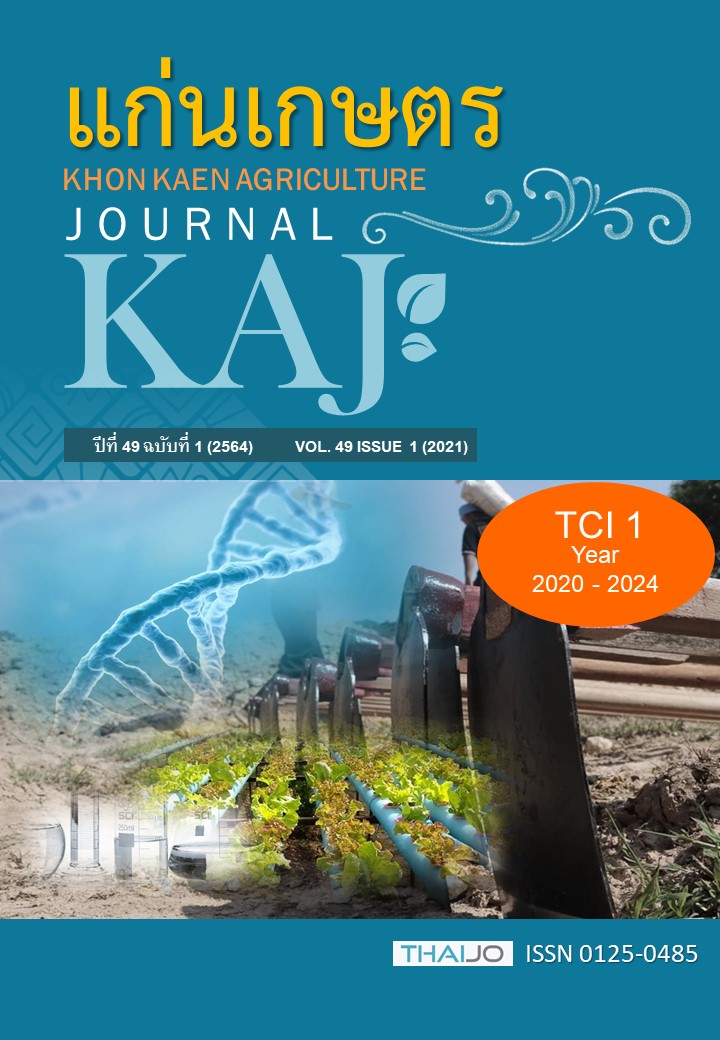การใช้คลื่นความถี่วิทยุในการควบคุมเหาหนังสือ (Liposcelis entomophila) ในเมล็ดข้าวหอมมะลิ
Main Article Content
บทคัดย่อ
เหาหนังสือ ถือเป็นปัญหาสำคัญของผลผลิตข้าวหอมมะลิในระยะหลังการเก็บเกี่ยว เนื่องจากเข้าทำลายบริเวณจมูกข้าวของเมล็ดหรือบริเวณที่จะเจริญไปเป็นต้นพืช ก่อให้เกิดความเสียหายแก่ผลผลิตในโรงเก็บทั้งเชิงปริมาณและคุณภาพ และสามารถแพร่ขยายพันธุ์ได้ง่าย ทำให้มีประชากรเพิ่มขึ้นอย่างรวดเร็ว เหาหนังสือที่พบในข้าวสารหอมมะลิ เมื่อนำมาจำแนกชนิดพบว่าเป็นชนิด Liposcelis entomophila การทดลองนี้มีวัตถุประสงค์เพื่อศึกษาระดับของการใช้อุณหภูมิ และเวลาที่เหมาะสมในการควบคุมเหาหนังสือโดยการใช้คลื่นความถี่วิทยุ โดยแบ่งการทดลองเป็น 2 การทดลอง ได้แก่ การทดลองที่ 1 นําเหาหนังสือแต่ละระยะการเจริญเติบโตมาผ่านคลื่นความถี่วิทยุที่ความถี่ 27.12 MHz อุณหภูมิ 55 องศาเซลเซียส เป็นเวลา 60 วินาที โดยเหาหนังสือระยะไข่มีค่าเฉลี่ยของการตายมากที่สุด เท่ากับ 92.76 ± 1.13 % รองลงมาคือ ระยะตัวอ่อน และระยะตัวเต็มวัย มีค่าเฉลี่ยของการตายเท่ากับ 63.12 ± 5.78 % และ 20.36 ± 2.40 % ตามลำดับ โดยที่ระยะตัวเต็มวัยของเหาหนังสือมีความทนทานต่อคลื่นความถี่วิทยุมากที่สุด แตกต่างอย่างมีนัยสําคัญทางสถิติ (P < 0.05) การทดลองที่ 2 นำเหาหนังสือตัวเต็มวัยซึ่งเป็นระยะที่ทนทานต่อคลื่นความถี่วิทยุมากที่สุดมาผ่านคลื่นที่ระดับอุณหภูมิ 55, 60, 65 และ 70 องศาเซลเซียส เป็นเวลา 60, 90, 120 และ 150 วินาที ในทุกระดับอุณหภูมิ พบว่า ที่ระดับอุณหภูมิ 65 องศาเซลเซียส เป็นเวลา 90 วินาที ซึ่งเป็นอุณหภูมิ และเวลาต่ำที่สุดที่สามารถทำให้ตัวเต็มวัยเหาหนังสือตายอย่างสมบูรณ์ (การตายเท่ากับ 100 %) และไม่พบแมลงรุ่นลูก (F1)
Article Details

อนุญาตภายใต้เงื่อนไข Creative Commons Attribution-NonCommercial-NoDerivatives 4.0 International License.
เอกสารอ้างอิง
มัณฑนา นครเรียบ. 2563. ประโยชน์ที่ดีต่อสุขภาพของข้าวกล้องงอกและข้าวฮากงอก. แหล่งข้อมูล: http://sciencejournal.pbru.ac.th/index.php/component/phocadownload/category/7-9-1-2555?download=34:70-80. ค้นเมื่อ 25 พฤษภาคม 2563
กฤษณา สุเมธะ เยาวลักษณ์ จันทร์บาง วิเชียร เฮงสวัสดิ์ และ ณัฐศักดิ์ กฤติกาเมษ. 2552. ผลของการใช้คลื่นความถี่วิทยุต่อมอดหัวป้อมและคุณภาพของข้าวสารพันธุ์ขาวดอกมะลิ 105. หน้า 97-103. ใน: รายงานสัมมนาวิชาการ บัณฑิตศึกษาเกษตรศาสตร์ คณะเกษตรศาสตร์ มหาวิทยาลัยเชียงใหม่ ครั้งที่ 6. 12-13 มีนาคม 2552. คณะเกษตรศาสตร์ มหาวิทยาลัยเชียงใหม่, เชียงใหม่.
ชัชพงษ์ ศรีคำ เยาวลักษณ์ จันทร์บาง และ ณัฐศักดิ์ กฤติกาเมษ. 2557. การใช้คลื่นความถี่วิทยุเพื่อควบคุมมอดฟันเลื่อยในข้าวสารพันธุ์ขาวดอกมะลิ 105. วารสารเกษตร. 30: 253-262.
ณัฏฐพร อุทัยมงคล วาสนา ฤทธิ์ไธสง คมศร แสงจินดา และชลิตา อุณหวุฒิ. 2554. การศึกษาวิเคราะห์และประเมินความเสี่ยงศัตรูพืชสำหรับการนำเข้าเมล็ดพันธุ์ข้าวโพดจากประเทศญี่ปุ่น. ผลงานวิจัยประจำปี 2555 สำนักวิจัยพัฒนาการอารักขาพืช เล่มที่ 3. วารสารวิชาการเกษตร. 1254-1417.
ณัฐศักดิ์ กฤติกาเมษ. 2543. การใช้คลื่นความร้อนเพื่อลดความชื้นและการทำลายเชื้อ Aspergillus flavus ในเมล็ดถั่วลิสง. รายงานการวิจัยโครงการวิจัยเพื่อพัฒนานักวิจัยรุ่นใหม่. มหาวิทยาลัยเชียงใหม่, เชียงใหม่. 33 หน้า.
วีรยุทธ ใฝ่กระจายเพื่อน เยาวลักษณ์ จันทร์บาง และ สุชาดา เวียร์ศิลป์. 2554. ผลของความร้อนจากคลนความถี่วิทยุต่อด้วงงวงข้าวโพด (Sitophilus zeamais). วารสารวิทยาศาสตร์เกษตร. 42: 392-395.
อภิรดี มานะสุวรรณผล. 2560. การจำแนกชนิดเหาหนังสือที่เข้าทำลายข้าวโพดในโรงเก็บ. ปัญหาพิเศษ ปริญญาตรี ภาควิชากีฏวิทยาและโรคพืช คณะเกษตรศาสตร์ มหาวิทยาลัยเชียงใหม่, เชียงใหม่.
Abbott, W. S. 1925. A method of computing the effectiveness of an insecticide. Journal of Economic Entomology. 18: 256-267.
Agricultural Research Service (ARS). 2019. Stored-product psocid identification website. Available: https://www.
ars.usda.gov/plains-area/mhk/cgahr/spieru/docs/psocid-id-introduction/. Accessed Jan. 16, 2020.
Athanassiou, C. G., F. H. Arthur, J. E. Throne, G. P. Opit, M. M. Hasan, M. J. Aikins, T. W. Phillips and N. G. Kavallieratos. 2010. Efficacy of insecticides for control of stored-product psocids. 805-814. In: 10th International Working Conference on Stored Product Protection. June, 27- July, 2, 2010, Estoril, Portugal.
Australian Bureau of Agricultural and Resource Economics (ABARE). 2000. Australian Commodities Volume 7, No 4, ACT, Canberra, Australia.
Birla, S. L., S. Wang, J. Tang and G. Hallman. 2004. Improving heating uniformity of fresh fruit in radio frequency treatments for pest control. Postharvest Biology and Technology. 33: 205-217.
Cao, Y., Y. Song, and G. Sun. 2003. A survey of psocid species infesting stored grain in China and resistance to phosphine in field populations of Liposcelis entomophila (Enderlein) (Psocoptera: Liposcelididae). pp. 662-667. In: P. F. Credland, D. M. Armitage, C. H. Bell, P. M. Cogann and E. Highley (eds). Proceedings of the 8th International Working Conference on Stored Product Protection. York.
Chanbang, Y. and N. Muenmanee. 2018. Radio frequency heat treatment for controlling cigarette beetle in dried tobacco. 497-501. In: 12th International Working Conference on Stored Product Protection (IWCSPP). October, 7-11, 2018, Berlin, Germany.
Cui, J., Y. Su, H. Li, and Z. Li. 2019. First record of Liposcelis entomophila (Enderlein) (Psocodea: Liposcelididae) from Sri Lanka based on morphological and molecular data. Journal of Zoological Systematics and Evolutionary Research. 44: 304–315.
Cwiklinski, M. and D. von Hoersten. 1999. Thermal treatment of seeds using microwave or radio-frequency energy for eradicating seedborne fungi. Paper No. 997010. Transaction of the ASABE. St. Joseph, Michigan.
Cwiklinski, M. and D. von Hoersten. 2001. Effect of exposure to radio-frequency electric fields on Fusarium graminearum in wheat seed. Paper. No. 016171. Transaction of the ASABE. St. Joseph, Michigan.
Jacobs, S. B. 2014. Booklice. Fact sheets. Department of Entomology, Collage of Agricultural Sciences, Pennsylvania State University.
Nayak, M. K. 2006. Psocids and mite pests of stored commodities: small but formidable enemies. pp. 1061-1073. In: I. Lorini, B. Bacaltchuk, H. Beckel, E. Deckers, E. Sundfeld, J. P. dos Santos, J. D. Biagi, J. C. Celaro, L. R. D’A. Faroni, L. de O. F. Bortolini, M. R. Sartori, M. C. Elias, R. N. C. Guedes, R. G. da Fonseca and V. M. Scussel (eds). Proceedings of the 9th International Working Conference on Stored Products Protection. Brazilian Post-harvest Association, Passo Fundo, RS, Brazil.
Nelson, S. O. 1996. Review and assessment of radio - frequency and microwave energy for stored-grain insect control. Transaction of the ASAE. 39: 1475-1484.
New, T. R. 1974. Handbooks for The Identification of British insects. Royal Entomological Society. London. 102 pp.
Opit, G., J. Throne, and K. Friesen. 2019. Stored-product psocid identification website. Available: https://www.ars.usda.gov/plains-area/mhk/cgahr/spieru/docs/psocid-id-introduction/. Accessed Dec. 15, 2019.
Pike, V. 1994. Laboratory assessment of the efficacy of phosphine and methyl bromide fumigation against all life stages of Liposcelis entomophilus (Enderlein). Crop Protection. 13: 141-145.
Rees, D. 2004. Insects of Stored Products. CSIRO Publishing, Collingwood Victoria, Australia, 190 pp.
Yang, Q., Z. Kucerova, Z. Li, I. Kalinovic, V. Stejskal, G. Opit, and Y. Cao. 2012. Diagnosis of Liposcelis entomophila (Insecta: Psocodea: Liposcelididae) based on morphological characteristics and DNA barcodes. Journal of Stored Products Research. 48: 120-125.


